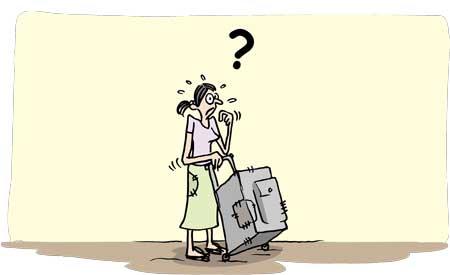Reply To:
Name - Reply Comment
Migrant worker departures reducing over the past year has caused some concerns for the Government of Sri Lanka (GoSL) and foreign employment agencies.
It’s caused due to the global pandemic, but more than the health concerns the authorities here must consider the agony they’ll experience when scaling down to a lower level of living.
As many as 40,000 Sri Lankan migrant workers were repatriated due to job losses. The worst hit are those fitting into the skilled labour class. Housemaids are next with a reading of 28.6% of the migrant worker departure figures. Unskilled labour migrants account for 26 % of departures with the professionals who seek employment abroad being 5.5 % of total migrant departures.
 What can these returnees do in Sri Lanka in keeping with their lofty ambitions?
What can these returnees do in Sri Lanka in keeping with their lofty ambitions?
It’s not that working abroad is easy. We’ve read enough reports of how challenging employment is in South Korea. Sri Lankan deaths in those countries were linked to murder, accidents and suicide. We read about Rizana Nafeek’s incident. We’ve come to know about employment issues in Middle Eastern countries. 82% of the employment departures were to the Middle Eastern region.
Even the Government of Sri Lanka accepts that a facelift is needed to reemploy those who have returned to the country after losing jobs.
Another sector which needs a boost is the foreign employment agencies. As much as 31.1% of labour migrants see their travels and employment abroad being facilitated by these agencies.
Sarath (the true name of the individual is concealed to protect privacy) returned to Sri Lanka from the Middle East after being employed there for over four years as a skilled labourer. With his savings he obtained a bus through a leasing facility. Now, after doing the business for almost a year, he finds operating the bus a challenge. This is because commuters (office workers) either don’t have money to pay the van fees due to pay cuts or have dropped out of being passengers because they are now working from home. Sarath was a dejected man when close associates last saw him. He doesn’t operate the bus anymore because the money he earns from the remaining passengers doesn’t suffice to pay for fuel and cover other operating costs.
Loved ones of migrant workers here in Sri Lanka have had their anxious moments. The GoSL brought down many strandard Sri Lankans, but what has the regime done for their welfare? In the midst of the all the gloom Central Bank figures reveal that from May last year remittance inflows have increased. Apart from that Sri Lanka’s unemployment figure according to fourth quarter of last year stands at 5.2%. The unemployment figure was more when the previous calculation was done. It’s good if the regime doesn’t get carried away with figures on paper and works towards the welfare of migrant workers who have now returned to their motherland.